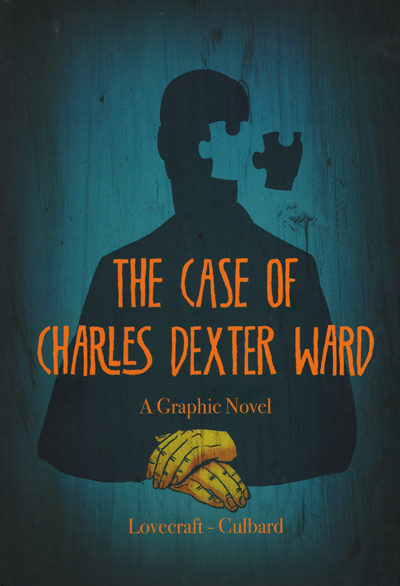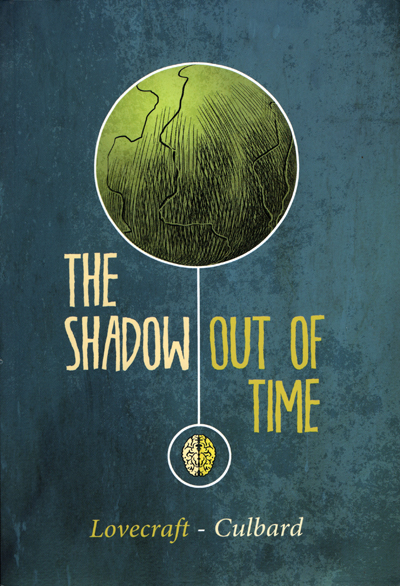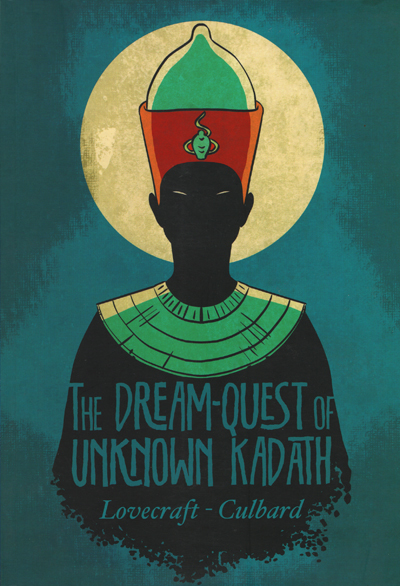|
| | |
|
A Lovecraft Comic Book Cover Gallery III:
The Case of Charles Dexter Ward +
(Culbard, 2013) |
|
| | |
|
|
|
This is the third installment in our Lovecraft themed cover galleries. Below, we present covers from The Case of Charles Dexter Ward and other stories adapted by I. N. J. Culbard and published in the United States by SelfMadeHero.
|
|
|
| | |
|
|
|
1

- title: The Case of Charles Dexter Ward
- publisher: SelfMadeHero
- cover artist: I. N. J. Culbard
- writer (adaptation): I. N. J. Culbard
- artist: I. N. J. Culbard
- issue: #1 of 1
- release date: April, 2013
- cover: A cover
- format: 6 ½" x 9 ½" graphic novel (128 pages)
- excerpt:
From a private hospital for the insane near Providence, Rhode Island, there recently disappeared an exceedingly singular person. He bore the name of Charles Dexter Ward, and was placed under restraint most reluctantly by the grieving father who had watched his aberration grow from a mere eccentricity to a dark mania involving both a possibility of murderous tendencies and a profound and peculiar change in the apparent contents of his mind. Doctors confess themselves quite baffled by his case, since it presented oddities of a general physiological as well as psychological character.
In the first place, the patient seemed oddly older than his twenty-six years would warrant. Mental disturbance, it is true, will age one rapidly; but the face of this young man had taken on a subtle cast which only the very aged normally acquire. In the second place, his organic processes shewed a certain queerness of proportion which nothing in medical experience can parallel. Respiration and heart action had a baffling lack of symmetry; the voice was lost, so that no sounds above a whisper were possible; digestion was incredibly prolonged and minimised, and neural reactions to standard stimuli bore no relation at all to anything heretofore recorded, either normal or pathological. The skin had a morbid chill and dryness, and the cellular structure of the tissue seemed exaggeratedly coarse and loosely knit. Even a large olive birthmark on the right hip had disappeared, whilst there had formed on the chest a very peculiar mole or blackish spot of which no trace existed before. In general, all physicians agree that in Ward the processes of metabolism had become retarded to a degree beyond precedent.
Psychologically, too, Charles Ward was unique. His madness held no affinity to any sort recorded in even the latest and most exhaustive of treatises, and was conjoined to a mental force which would have made him a genius or a leader had it not been twisted into strange and grotesque forms. Dr. Willett, who was Ward's family physician, affirms that the patient's gross mental capacity, as gauged by his response to matters outside the sphere of his insanity, had actually increased since the seizure. Ward, it is true, was always a scholar and an antiquarian; but even his most brilliant early work did not shew the prodigious grasp and insight displayed during his last examinations by the alienists. It was, indeed, a difficult matter to obtain a legal commitment to the hospital, so powerful and lucid did the youth's mind seem; and only on the evidence of others, and on the strength of many abnormal gaps in his stock of information as distinguished from his intelligence, was he finally placed in confinement. To the very moment of his vanishment he was an omnivorous reader and as great a conversationalist as his poor voice permitted; and shrewd observers, failing to foresee his escape, freely predicted that he would not be long in gaining his discharge from custody.
—The Case of Charles Dexter Ward, H.P. Lovecraft (1927) (full text)
|
|
|
| | |
|
|
|
2

- title: The Shadow Out of Time
- publisher: SelfMadeHero
- cover artist: I. N. J. Culbard
- writer (adaptation): I. N. J. Culbard
- artist: I. N. J. Culbard
- issue: #1 of 1
- release date: October, 2013
- cover: A cover
- format: 6 ½" x 9 ½" graphic novel (120 pages)
- excerpt:
After twenty-two years of nightmare and terror, saved only by a desperate conviction of the mythical source of certain impressions, I am unwilling to vouch for the truth of that which I think I found in Western Australia on the night of 17-18 July 1935. There is reason to hope that my experience was wholly or partly an hallucination - for which, indeed, abundant causes existed. And yet, its realism was so hideous that I sometimes find hope impossible.
If the thing did happen, then man must be prepared to accept notions of the cosmos, and of his own place in the seething vortex of time, whose merest mention is paralysing. He must, too, be placed on guard against a specific, lurking peril which, though it will never engulf the whole race, may impose monstrous and unguessable horrors upon certain venturesome members of it.
It is for this latter reason that I urge, with all the force of my being, final abandonment of all the attempts at unearthing those fragments of unknown, primordial masonry which my expedition set out to investigate.
Assuming that I was sane and awake, my experience on that night was such as has befallen no man before. It was, moreover, a frightful confirmation of all I had sought to dismiss as myth and dream. Mercifull there is no proof, for in my fright I lost the awesome object which would - if real and brought out of that noxious abyss - have formed irrefutable evidence.
When I came upon the horror I was alone - and I have up to now told no one about it. I could not stop the others from digging in its direction, but chance and the shifting sand have so far saved them from finding it. Now I must formulate some definite statement - not only for the sake of my own mental balance, but to warn such others as may read it seriously.
—The Shadow Out of Time, H.P. Lovecraft (1935) (full text)
|
|
|
| | |
|
|
|
3

- title: The Dream Quest of Unknown Kadath
- publisher: SelfMadeHero
- cover artist: I. N. J. Culbard
- writer (adaptation): I. N. J. Culbard
- artist: I. N. J. Culbard
- issue: #1 of 1
- release date: November, 2014
- cover: A cover
- format: 6 ½" x 9 ½" graphic novel (144 pages)
- excerpt:
Suddenly, without a warning sound in the dark, Carter felt his curved scimitar drawn stealthily out of his belt by some unseen hand. Then he heard it clatter down over the rocks below. And between him and the Milky Way he thought he saw a very terrible outline of something noxiously thin and horned and tailed and bat-winged. Other things, too, had begun to blot out patches of stars west of him, as if a flock of vague entities were flapping thickly and silently out of that inaccessible cave in the face of the precipice. Then a sort of cold rubbery arm seized his neck and something else seized his feet, and he was lifted inconsiderately up and swung about in space. Another minute and the stars were gone, and Carter knew that the night-gaunts had got him.
They bore him breathless into that cliffside cavern and through monstrous labyrinths beyond. When he struggled, as at first he did by instinct, they tickled him with deliberation. They made no sound at all themselves, and even their membranous wings were silent. They were frightfully cold and damp and slippery, and their paws kneaded one detestably. Soon they were plunging hideously downward through inconceivable abysses in a whirling, giddying, sickening rush of dank, tomb-like air; and Carter felt they were shooting into the ultimate vortex of shrieking and daemonic madness. He screamed again and again, but whenever he did so the black paws tickled him with greater subtlety. Then he saw a sort of grey phosphorescence about, and guessed they were coming even to that inner world of subterrene horror of which dim legends tell, and which is litten only by the pale death-fire wherewith reeks the ghoulish air and the primal mists of the pits at earth's core.
At last far below him he saw faint lines of grey and ominous pinnacles which he knew must be the fabled Peaks of Throk. Awful and sinister they stand in the haunted disc of sunless and eternal depths; higher than man may reckon, and guarding terrible valleys where the Dholes crawl and burrow nastily. But Carter preferred to look at them than at his captors, which were indeed shocking and uncouth black things with smooth, oily, whale-like surfaces, unpleasant horns that curved inward toward each other, bat wings whose beating made no sound, ugly prehensile paws, and barbed tails that lashed needlessly and disquietingly. And worst of all, they never spoke or laughed, and never smiled because they had no faces at all to smile with, but only a suggestive blankness where a face ought to be. All they ever did was clutch and fly and tickle; that was the way of night-gaunts.
—The Dream-Quest of Unknown Kadath, H.P. Lovecraft (1927) (full text)
|
|
|
| | |
|
|
|
4

- title: At the Mountains of Madness
- publisher: SelfMadeHero
- cover artist: I. N. J. Culbard
- writer (adaptation): I. N. J. Culbard
- artist: I. N. J. Culbard
- issue: #1 of 1
- release date: December, 2019
- cover: A cover
- format: 6 ½" x 9 ½" graphic novel (128 pages)
- excerpt:
Danforth and I have recollections of emerging into the great sculptured hemisphere and of threading our back trail through the Cyclopean rooms and corridors of the dead city; yet these are purely dream fragments involving no memory of volition, details, or physical exertion. It was as if we floated in a nebulous world or dimension without time, causation, or orientation. The gray half-daylight of the vast circular space sobered us somewhat; but we did not go near those cached sledges or look again at poor Gedney and the dog. They have a strange and titanic mausoleum, and I hope the end of this planet will find them still undisturbed.
It was while struggling up the colossal spiral incline that we first felt the terrible fatigue and short breath which our race through the thin plateau air had produced; but not even fear of collapse could make us pause before reaching the normal outer realm of sun and sky. There was something vaguely appropriate about our departure from those buried epochs; for as we wound our panting way up the sixty-foot cylinder of primal masonry, we glimpsed beside us a continuous procession of heroic sculptures in the dead race’s early and undecayed technique - a farewell from the Old Ones, written fifty million years ago.
—At the Mountains of Madness, H.P. Lovecraft (1931) (full text)
|
|
|
| | |
|
|
| more galleries |
|
|
| | |
|
|